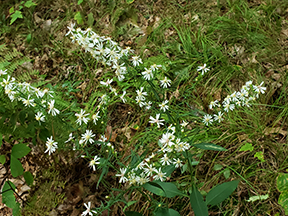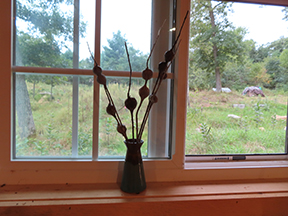Naturalist Notes
featuring Dr. Diane Lueck
4-15-2021
Non-flowering Plants
Have you ever taken a walk along a wooded edge and seen a
bank of moss so green and welcoming that you want to just sink right into it? While
waiting (impatiently) for the wildflowers in Central Wisconsin to bloom, I’m
captivated by the diverse non-flowering plants—mosses and ferns. And lichens, the combination of algae and
fungus. So, really, not a plant at all,
but don’t get me started.
Walking through cutover pines, I notice that each stump has
its own cap of mnium or polytrichum, haircap moss. Some add a decorative patch of British
soldiers, the lichen Cladonia cristatella, to the cap. These rotting stumps provide nutrients, and
the mosses hold the water, for a nursery of seedlings. Whole logs and branches disappear under these
ministrations, eventually dissolving into the organic layer. Mosses, in
addition to being non-flowering, are also non-vascular. That means they don’t have the woody
structures that other plants do. It’s
the reason mosses stay low to the ground or substrate.
I’m fascinated by the reproductive processes of these
plants. Mosses require water, whether from rain or dew, to propagate. Underground rhizoids, arising from spores, are
either positive or negative (male or female, if you wish). When they meet, they form a gamete and sprout
up the green body. Some of these gametophores
become spore-producing stalks. Note the
picture with the tiny spore capsules beginning, looking like the hair cap of
the common name.
In a sandy path, Reindeer lichen (Cladonia rangiferina)
abounds. This lichen gets crunchy,
crispy, and then reacts with resilient succulence in the dew or rain. A variety of shield lichens pop on trees and
rocks, in shades of sage, yellow, brown and black. Lycopodium club moss (not a true moss) grows
in patches like fancy tiny trees. Ancient species that have survived to modern
day! Fascinating stories.
So, I’m heading out to the woods edge. To listen for spring warblers passing
through, to sink into the cushion of mosses and pretend I’m a woodland critter
living there. To wait for wildflowers to bloom.
(photos: Polytrichum, lycopodium, reindeer lichen)
![]()
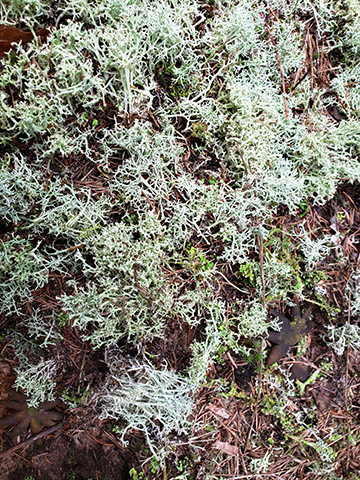
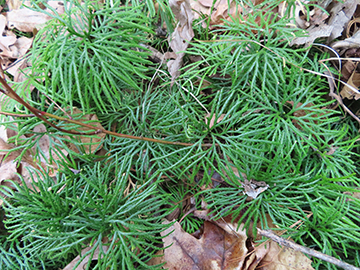
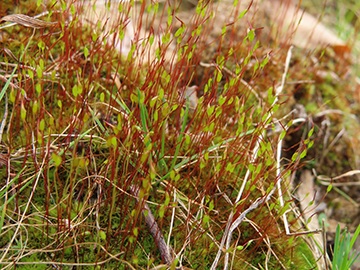
March 18, 2021, Snow Fleas and Other Hidden Critters
Snow is retreating from Central Wisconsin—though we might
get another batch in March (or April). As
the sun warms the last of the snow, a phenomenon happens. As you walk, it looks
like someone is sprinkling pepper along your tracks (photo credit Sam Lau).
When you look closely, the pepper grains move!
What is that??? You’ve been
visited by snow fleas. Also known as
springtails, these are Collembola, insects only a millimeter or two long. The
tail, folded back as you can see in the enlarged picture (NC-State), “springs”
to help these critters move with a popping, hopping motion.
Collembola are among a group of tiny, beneficial insects
that live in leaf litter, breaking it down by eating decaying vegetation,
fungi, bacteria and algae. Collectively,
these insects can be called detritivores—eaters of detritus, dead plants or
animals. In early spring, these
temperature-dependent critters stir with the sun warming their organic layer
home. Some are nearly microscopic, like
wood ticks (acari). Others can be seen with the naked eye, as springtails,
millipedes, and beetle larvae.
A big favorite of mine is an insect that preys on other
detritivores, the pseudoscorpion. This
beautiful reddish-brown critter has the pincers of a crab and chubby body of a
tick. I have been lucky enough to see
one large enough to identify without a scope, it must have been 6mm or so. The picture here is through a dissecting
scope, this beauty was probably 2mm.
You might be amazed at the number of insects that live in an
organic layer in an 8” circle on the forest floor! Collect just the leaf litter, not the
soil. Place it in a funnel with hardware
cloth in the tube part, so the litter doesn’t fall through. Place a light bulb at the top, to warm the
organic matter. The critters will move
away from the bulb, through the funnel, and into a jar of alcohol, from which
you can identify the ticks, mites, beetle larvae, and collembola. You may be fascinated! On the other hand, you may never want to sit
on the ground for a picnic again.
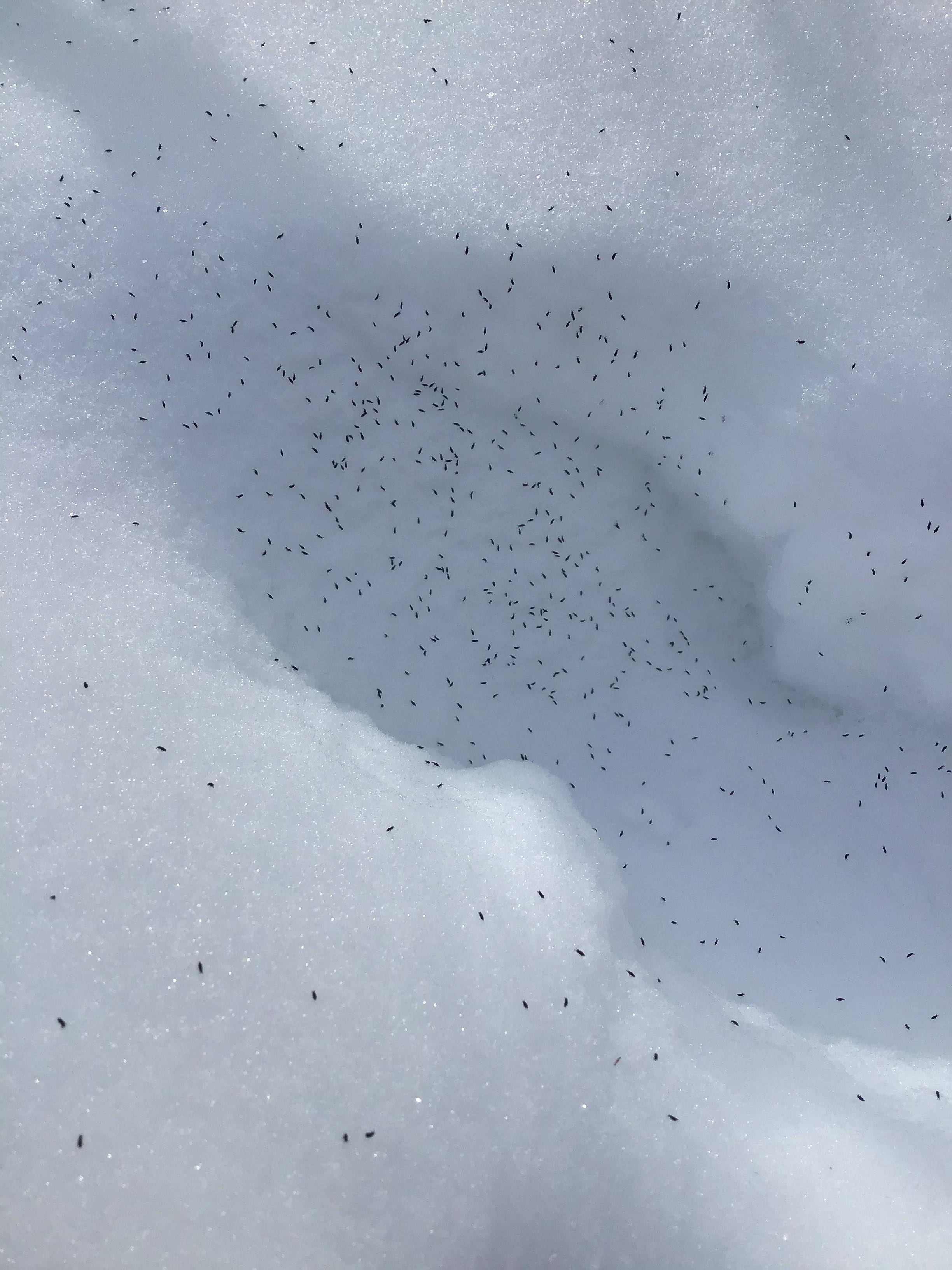
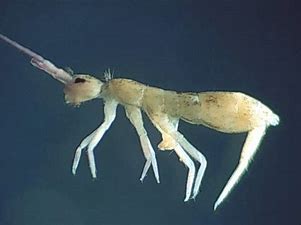
.JPG)
March 5, 2021 Maple Syrup Time
Chickadees are singing “Hi Sweetie” instead of the “Dee-dee-dee”
they call in fall and winter. Each
morning, snow is melting off the roof.
Each night, it freezes again.
Freeze, thaw, freeze, thaw. That
is what happens in the maple trees as well.
During the warming, sunny days, sap is rising through the xylum heading
for those bright red buds. As
temperature drops in evening, so does the sap, waiting in the roots for the
next warm day. Snow crystals melt into
sugar snow—grains rather than flakes, reflecting the freeze thaw cycle as
well. It’s time for maple syrup.
My friends who tap maple trees are excited and happy to
share their experiences. (Picture of syruping hike courtesy of Jeremy Solin.) You
might gather sap the old-fashioned way in buckets hanging from taps. Some syrup
producers have gone high tech, with a system like a milking parlor, harvesting
via tubes and bags. I can’t imagine a
better smell than maple sap evaporating down to syrup over a wood fire. Keep a close eye on the change from sap to
syrup. The clear sap is about 2-3% sugar, and you cook it down to around
67%. It takes 40 gallons of sap to make
one gallon of syrup! You don’t want to
waste that. If you are in a sugaring state,
you likely have a maple syrup producers association. You’ll get way better information than I can
provide.
Here in Central
Wisconsin, my woodlot holds mostly red maple (Acer rubrum) and some silver
(Acer saccarinum). Further north is the
true maple tapping species, Acer saccarum (sugar maple). I’ve also heard that you can make syrup from
birch sap (Betula spp.) and even walnut (Juglans spp.), but I don’t know anyone
who has done that.
Syrup on waffles, in coffee, poured on snow and cooled to
candy. Nothing is better as a thank-you gift than some local maple syrup. I
hope you can find specialty Tapped Syrup by Jeremy Solin, infused with cinnamon
or cardamom, among my favorites. YUM. I
live in Amish country in Waushara County, and will be looking for syrup at the local
farm market and bakery shop. Or, look
for the Something Special from Wisconsin label, and enjoy the generosity of our
spring maple trees.
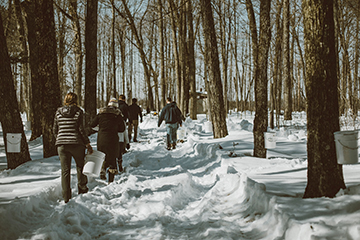
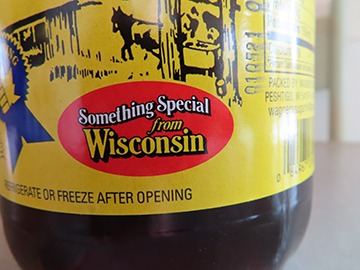
February 14, 2021 Stories
in the Snow
Growing up outdoors in Central Wisconsin, I’ve been
fortunate to see animal stories in the sandy lanes, the muddy paths, and the
snow. Imagining myself part of the indigenous
Woodland Culture that once hiked my hills, I wore leather slippers as a child so
I could feel the ground through my feet.
I learned the distinctive tracks and patterns of squirrel, rabbit,
mouse, and deer. I investigated scat and the gnawed browse tips on twigs.
Earlier this winter, the snow wasn’t particularly deep. I was able to skip snowshoes, and follow
animal tracks with ease. I wonder at the
endurance of the tiniest critters, those mice, voles, weasels that stay active
in the fluffy, insulating flakes. I enjoyed
the tracks of a troop of turkeys going up my hill. A deer path was well used. Surprising to me, deer tend to “lazily” follow
a stomped path or cleared lane—good to know if you’re a hunter. After I break trail, I often see their
pointed, heart-shaped tracks following mine.
One cold January some years ago, I was walking in a quiet,
snowy swamp. I wandered, anticipating
finding shed antlers in a month or so.
Then I spotted heel-toe, heel-toe tracks that reminded me of fancy
embroidery on my great-grandmother’s patchwork quilt. Ruffed grouse. I followed them along, enjoying the thought
of these gallinaceous critters pacing slowly through tag alders on their way to
the next tasty buds. From the north came
another track—fox! Both red and gray
live in these swamps. Fox tracks joined
along grouse tracks. Would I see the end
of the narrative? Would I see the result
of a successful hunt? No—the chronicle
in the snow was the flushed wing tips that told the fox would need to chase
down a rabbit instead, this time.
(wing-snag picture by Sam Lau)
Bundle up to embrace the cold, and see what tracks you can
find. Whether by ski, snowshoe, or warm
winter boots, a trek in the woods can reward you with tales that will stay with
you into spring.
![20210212_100207[1].jpg](/cnr-ap/bowWI/PublishingImages/20210212_100207[1].jpg)
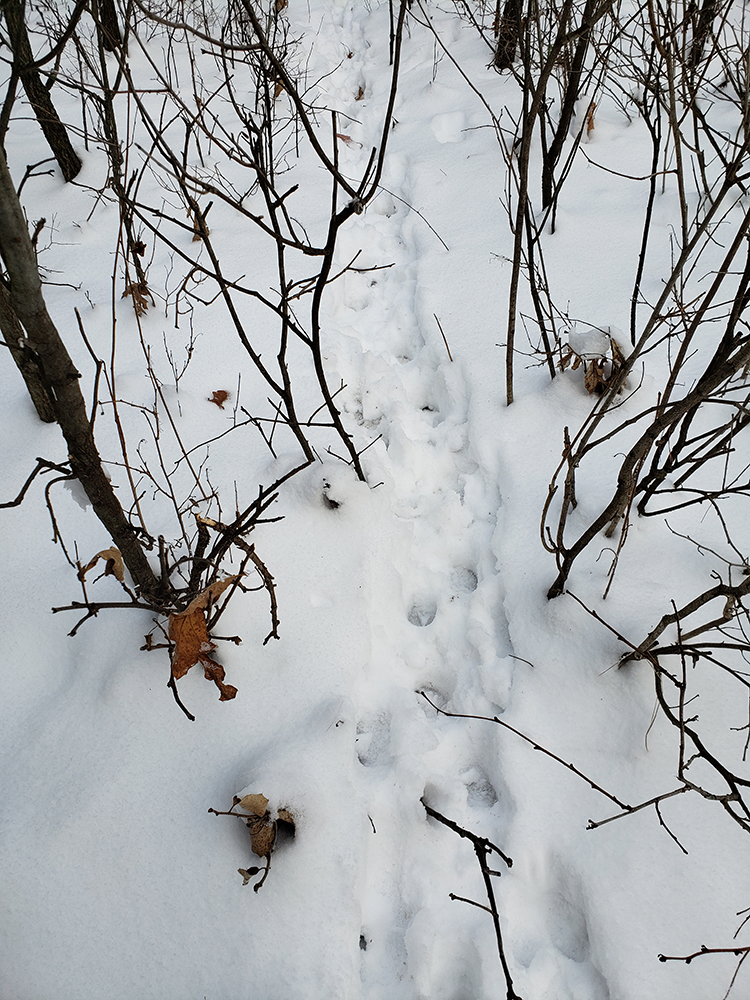
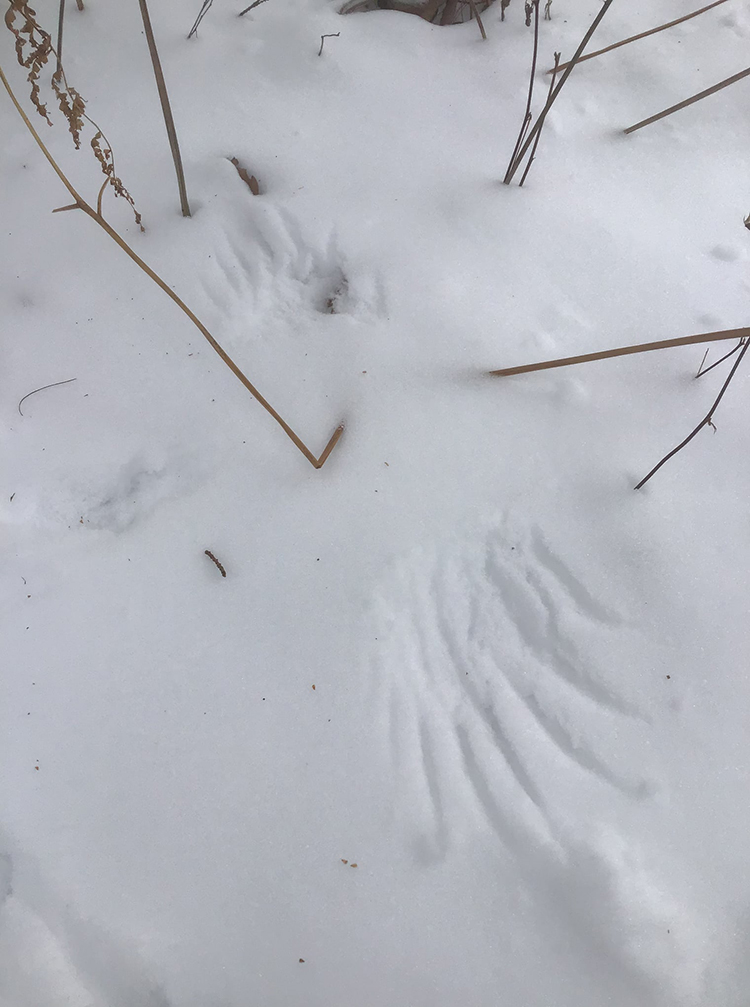
January 21, 2021 - Joys of Wood
My
cottage is small enough that I can heat primarily with wood—backup fuel heats
the basement in-floor pipes. Sure,
heating with wood means extra mess.
Leaving bark and chips, sand and snow in the living room makes for extra
cleanup. That problem is offset by snug,
comfortable, warm, cozy! Sitting by a
fire made from split, aged oak, birch or maple can add a whole level to a cup
of coffee or cocoa. Heating with wood
means thinking ahead. Felling dead or
dying trees, blocking to length, splitting and stacking to dry. It should be a continuing process, so you
always have some that’s perfectly dry and some that will be ready next year or
the next.
Some wood is better for firewood than others. Pine is only good for kindling, getting fires
started. It burns too fast for long-term
heat. So cut some of that and split it
small. You’ll be glad to have some dry starters, along with newspaper and
candle wax. Oak is the best
firewood. It has a dense grain, and will
burn long and hold heat. Maple and ash
are good too. Elm and birch are kind of
lightweights, and are good for a morning fire in fall when you don’t really
need to keep a hot fire going all day.
Another naturalist note. In your
woodlot, I hope you have a good diversity of trees. Any monoculture is susceptible to disease, such
as birch borer, pine beetle or blister rust, maple decline, Dutch elm disease,
or oak wilt. So encourage diversity. Any
dying trees are good to use for firewood, with one caveat. As soon as you can see them declining, cut
them now! Disease can deteriorate the
quality of firewood. For example, in the
fungal disease oak wilt, hyphae invade and clog the vessels and tracheids in
the oak grain. This makes the firewood
dry less evenly and burn poorly. Okay, let’s safely get those woodstoves fired
up and enjoy the crackling fire!
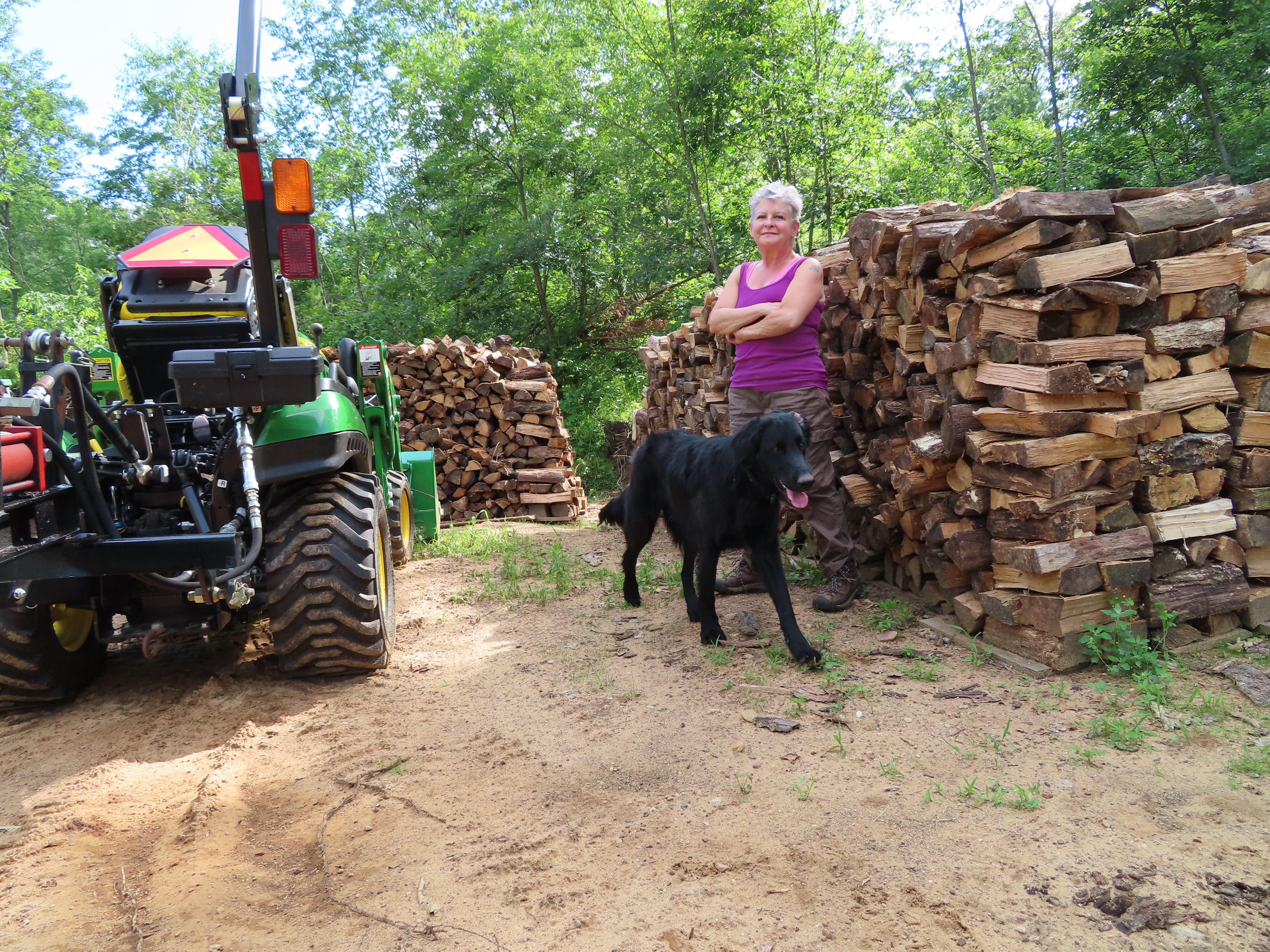

January 3, 2021 - Frost!
This week, the Midwest experienced a beautiful
phenomenon. Frost! Humidity, frost, cold temperatures and calm
winds all coalesced into spiky white needles on every available surface. I’ve always called this “hoar frost.” However, a spirited discussion ensued as many
people posted beautiful photos of this frosty event. Is it hoar frost, or rime ice? Is it hard or soft? Wow, who knew.
So, this naturalist got into learning mode, and got lost in
the labyrinth of terminology. Just like,
years ago, I was lost in the woods in a deep hoar frost morning. It was cold, quiet, completely still. I was in an unfamiliar woodlot, squirrel
hunting with my husband. The unfamiliar
woods were even stranger, as the thick frost and white sky disoriented me. The only objects that weren’t thickly white
were oak trunks, standing out distinctly and mysteriously against the frosted
trees. It was so quiet! It was so still! We felt like whispering as we moved among the
trees. The secrets, hidden landscapes,
concealed landforms! I have never again
been so immersed in such a mysterious sensation.
Back to the debate. According to numerous sources, our
January 2021 weather delight is Rime Ice.
It’s caused when dense fog freezes to solid objects. Even more specifically, our event was SOFT
rime ice. This caused long needles of
ice, which got longer each night as fog rolled in again! We had soft rime, long needles, because winds
were calm and allowed the needles to grow.
Hoar frost is feathery, not icy, and isn’t caused when fog is
present. Weather.com says “Hoar frost
is caused by a phase change from gaseous water vapor directly into ice when the
air reaches the frost point via cooling. It is similar to dew but when
temperatures are below freezing. It is not liquid dew that freezes. This type
of frost normally happens on a cold, clear, and calm night in the presence of
sufficient moisture.”
And, we haven’t even gotten into Frost Flowers, which form
around weed and grass stems, usually before there is any snow on the ground. Look it up!
They are awesome. What a fun experience!
Winter is wonderful!
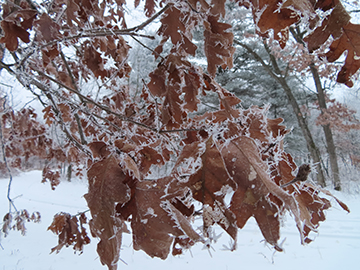
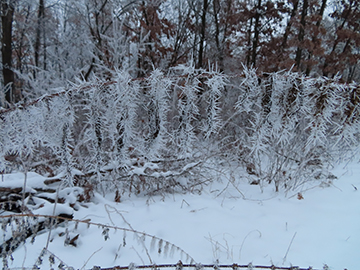
Dec 19, 2020 - Nature is amazing.
Eggs are amazing! Eggs are the
single largest cell in any female body. Look at these wonders of nature.
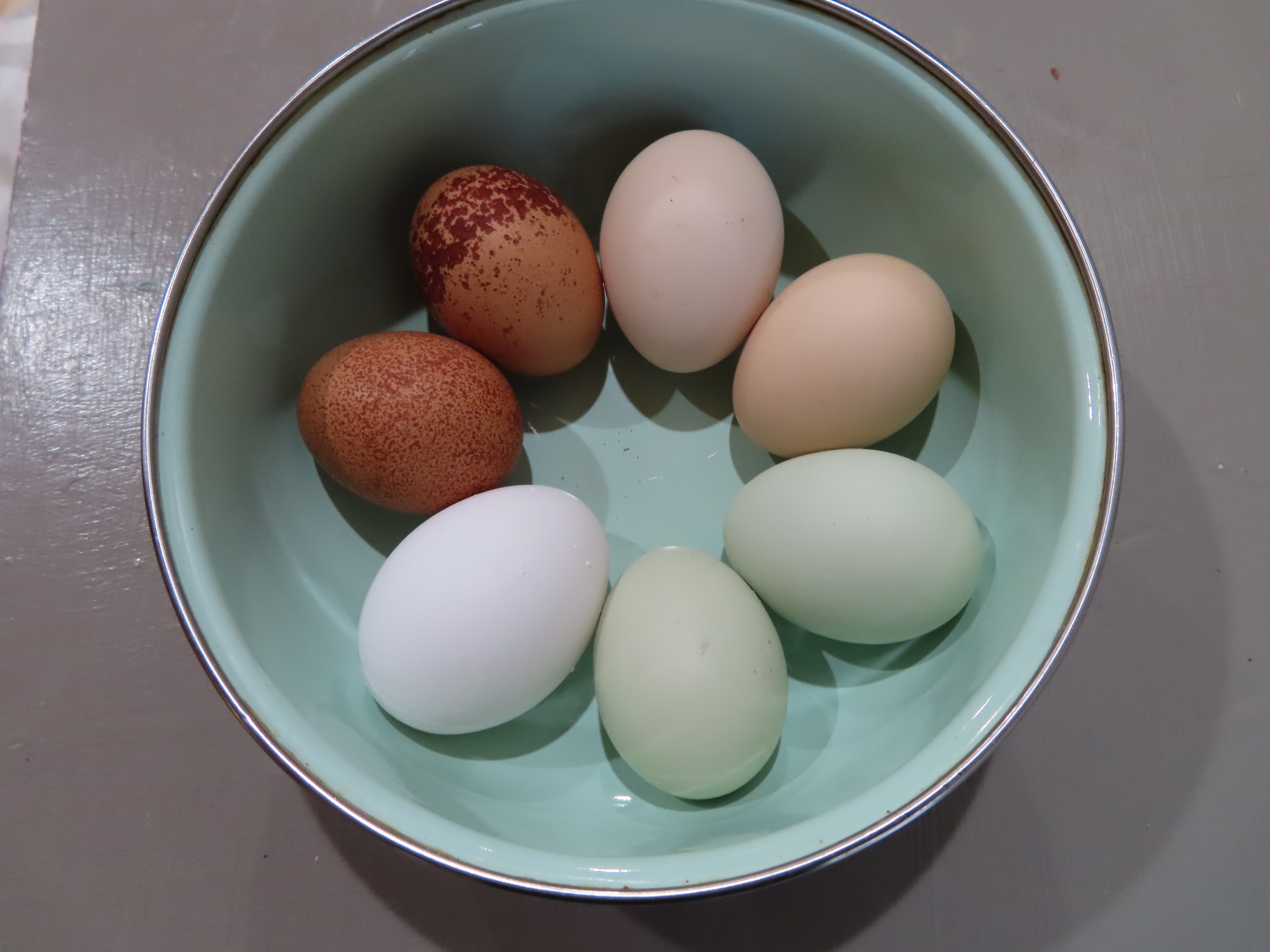
The smaller eggs are from pullets—the first eggs of young chickens. The
white egg is store-bought, from an adult hen.
Note the colors. Depending on the breed of chicken, you can get quite a
variety. Check out McMurry Hatchery online to see some cool colors, both of eggs and of chicken breeds.
Now for the Naturalist part.
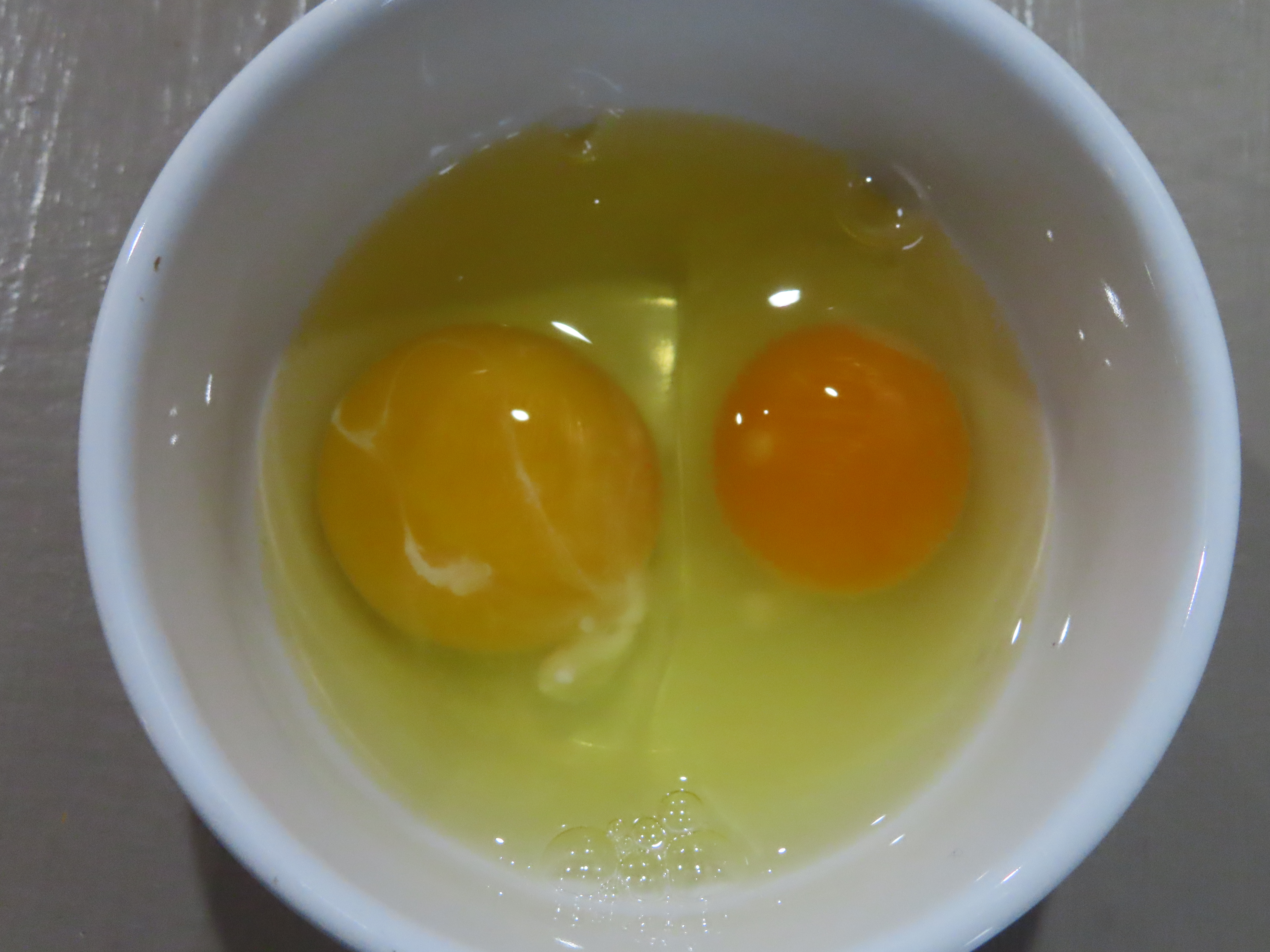
The larger yolk is from the adult, store egg. The smaller is from the pullet, who has
free-ranged since she hatched. Notice
the deeper color of the yolk. The
reason? Even this late in the year,
she’s still finding green grass and a few forbs, and maybe even protein-laden
bugs. That gives her yolk this deep,
dandelion gold yolk, and us the most healthy eggs you could possibly eat. I know many of you love chickens like I do,
and appreciate good eggs. I’m going to
add these to a spicy bibimbap with fresh veggies. Bon appetit!
November 18, 2020 - Walking my dog out to the prairie hills. As I rustle through the wooded path, my mind is on the upcoming gun deer season in Wisconsin. I’m looking forward to it, as I had surgery last year and couldn’t carry my rifle. My mind is full of deer and possibilities. Pre-playing scenarios has me over-imaginative. As we come out to the open prairie, the golden late afternoon sun hits the hills. I look north, and everything looks like deer. A clump of goldenrod. Dead raspberry canes. There is one stump on the far end of the field, brushy, that REALLY looks like a buck face and antlers. Of course, when you’re thinking deer, I repeat—everything looks like deer. I pull out my phone and zoom in. It’s still far, but that stump and branches really looks like a deer with antlers. I lower the phone. Then I think, wait! This is my PRAIRIE! I have worked hard to clear out the brushy stumps. It has to be, yep, a doe spooks and the stump gets up heavily and follows her. Why didn’t I move my finger just a fraction and take the picture when I could? I’ll never figure that out. So, enjoy the afternoon sun on some beautiful little bluestem instead.
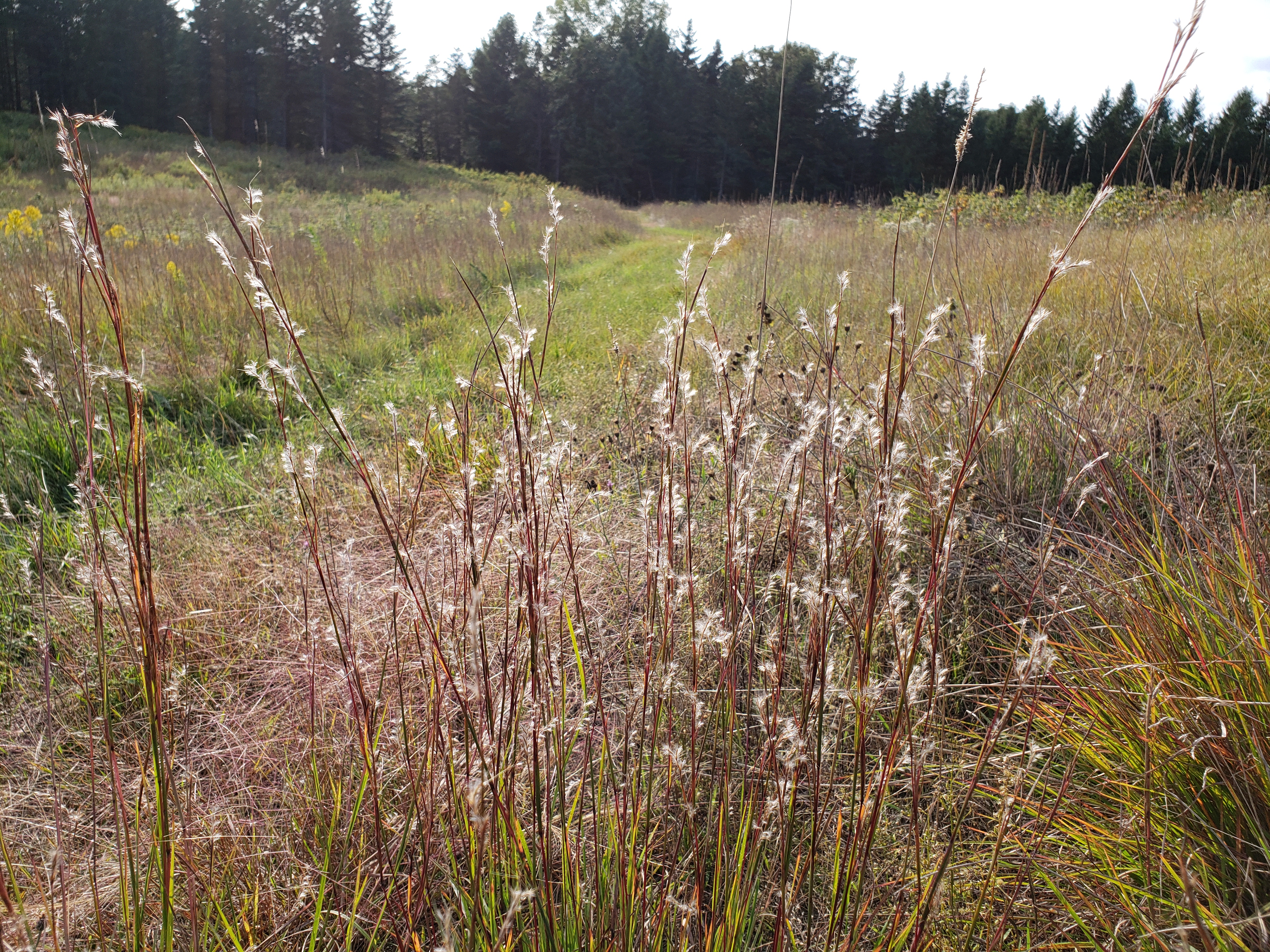
October 20, 2020 - Like many naturalists, I have an urge, a drive, a need to know and name what I see. Each flower, each bird, each mushroom. As an artist, I say to myself, relax! Breathe in the scent of fallen leaves. Hear the crunch and rustle. Watch for the flash of sunlight on a late spiderweb. But, wait! It’s a pointed oval! It’s 9 cm long with a 2 cm petiole! The margins are finely serrated! No, look at it this way: Can you imagine the restraint it took for the red side NOT to overrun the yellow? How even, how delicate, how perfect. But, it’s a black cherry leaf, I need to name it! Scientist, artist? Scientist, artist? The leaf says, “embrace them both.”
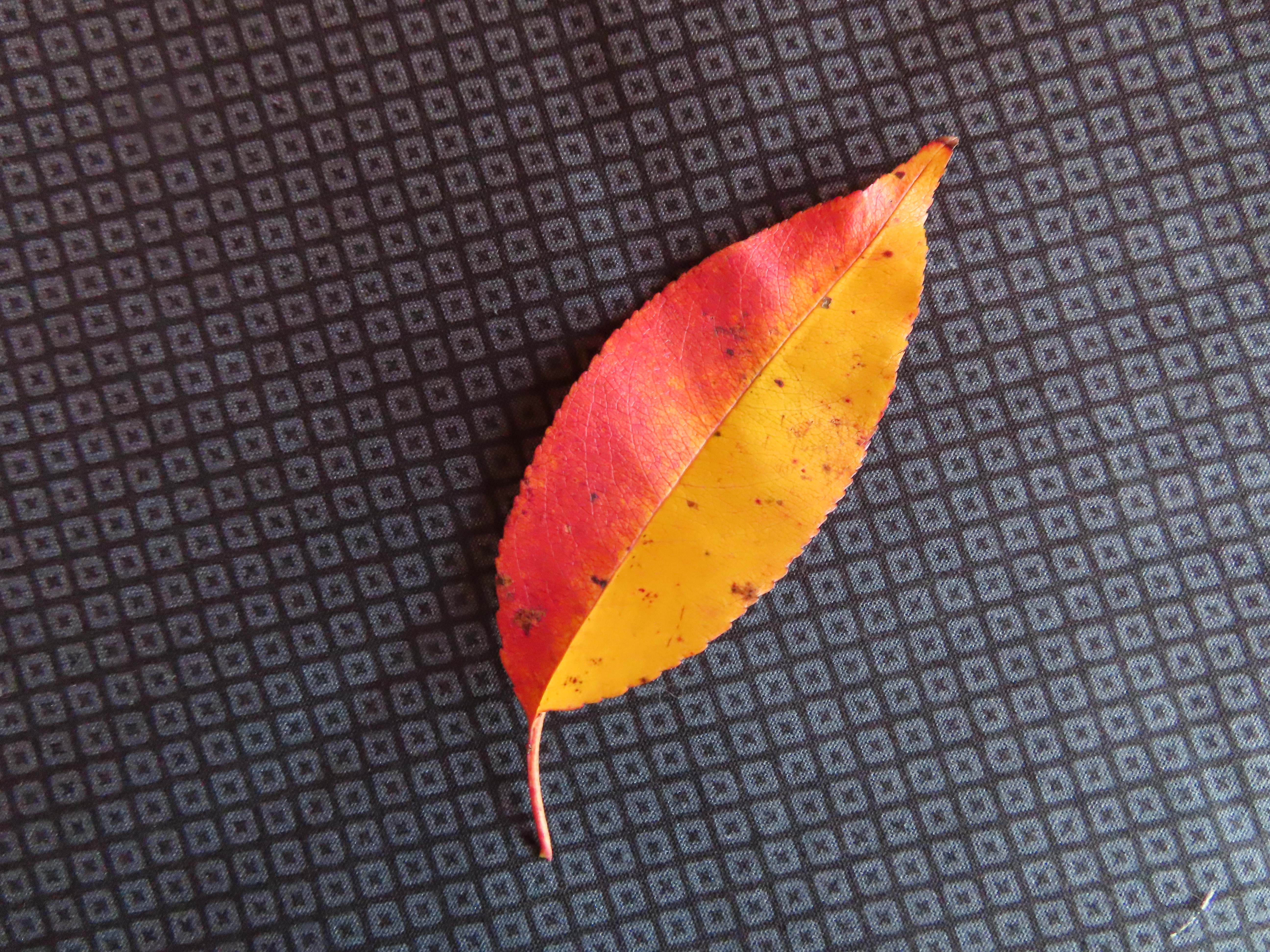
September 21, 2020 - Cairn. From Gaelic, a mound of rough stones built as a memorial or landmark. Have you seen these? Have you made one? They are piling up on the landscape in many places. Formerly, you would see them as a marker on a wilderness trail, for the direction to go. Now, trust your compass and your map instead. Many naturalists will say that piling stones is a problem, because they disturb the ecosystem beneath, and the critters that live there. I agree with that particularly in a river or stream, as the macroinvertebrates may be disturbed (although they often seem to hang pretty tight!).
For me, piling stones is meditative. I live in central Wisconsin on the terminal moraine of the last glacier, which pushed rocks from hundreds of miles north. The heavy ice brought its burden of granite, gneiss, basalt, quartzite, sandstone, chert. As it began to melt and recede, the glacier stopped, sighed, and left its rounded tumbled cargo in defeat.
Present time. This pile calls to me. A pile cleared from a farm field that sprouted new stones after the freeze and thaw of winter. After a rain, new rocks are revealed as the sandy soil melts away. I hold a stone, enjoying its mass, its weight, its shape. I feel for its center of gravity, finding my own.
![20200915_155113[1].jpg](/cnr-ap/bowWI/PublishingImages/20200915_155113[1].jpg)
September 14, 2020 - Early fall brings a panoply of asters! (In the definition of "a magnificent display.") The first sightings of native asters foreshadow the change of seasons--purple (Symphotrichum spp.), pictured white arrow-leaved (Symphotrichum urophyllum), and goldenrods (Solidago spp.). There are a huge number of Asteraceae species!
Many are late summer and fall, and we have a good number of natives. One of those, Canada goldenrod (pictured) is a great favorite of pollinators, as you can see. Goldenrod gets a bad reputation with allergy sufferers, who are actually reacting to the ragweed that blooms at the same time. This native aster spreads rapidly through root clones, forming large colonies that crowd out other valuable species. In my Central Wisconsin prairie, I mow a patch that covers nearly an acre. (Picture your entire home yard completely covered with this monoculture of goldenrod. Pretty, but not diverse.) But don't despair! My prairie is about 8 acres, and I leave many smaller patches of goldenrod and even leave the non-native bull thistle (another aster) for the pollinators. Goldenrod stems host insect larvae, making a round swollen gall. This doesn't seem to harm the plant at all, and they make a pretty dry display.
